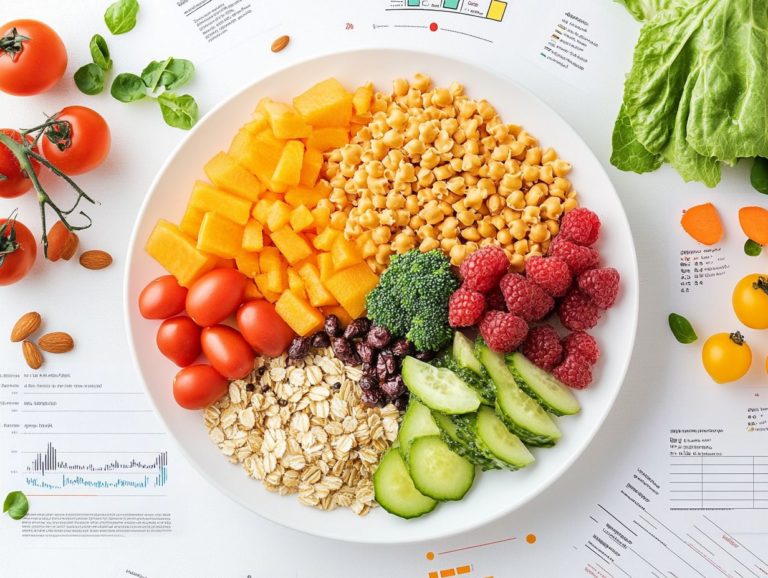The Connection Between Physical Activity and Dietary Guidelines
In today s fast-paced world, grasping the importance of physical activity and dietary guidelines is more essential than ever.
This article delves into the myriad benefits of regular exercise, highlighting its positive impact on both your body and mind.
You ll find a detailed breakdown of crucial nutritional recommendations designed to enhance your overall well-being. Together, these elements forge a powerful synergy that paves the way for a healthier lifestyle.
Let’s dive into some practical tips you can easily apply!
Contents
- Key Takeaways:
- The Importance of Physical Activity
- The Role of Dietary Guidelines
- How Physical Activity and Dietary Guidelines Work Together
- Incorporating Physical Activity and Dietary Guidelines into Daily Life
- Frequently Asked Questions
- What guidelines do the Dietary Guidelines for Americans recommend?
- How does physical activity impact dietary guidelines?
- Can meeting the physical activity guidelines allow for more flexibility in following dietary guidelines?
- Why is it important to follow both the physical activity and dietary guidelines?
- Can physical activity and dietary guidelines be personalized for individual needs?
- How can one incorporate physical activity and dietary guidelines into a busy schedule?
Key Takeaways:

Regular physical activity and following dietary guidelines are essential for overall health and well-being.
Physical activity and dietary guidelines work together to provide complementary effects on our physical and mental health.
Incorporating physical activity and dietary guidelines into our daily lives is crucial for maintaining a healthy lifestyle, and small changes can make a big difference.
What are Physical Activity and Dietary Guidelines?
Physical Activity and Dietary Guidelines are carefully designed recommendations that empower you to achieve optimal health and well-being through proper nutrition and regular exercise.
Developed by esteemed health professionals and organizations like the USDA, these guidelines encapsulate essential elements that promote an active lifestyle while addressing pressing health concerns such as obesity, diabetes, and cardiovascular disease.
Rooted in decades of rigorous research, these guidelines serve as a cornerstone for preventative health strategies. They ensure that you, regardless of age, can adapt your habits to enhance both longevity and quality of life.
By highlighting the significance of balanced nutrition illustrated through resources like USDA’s MyPlate you are encouraged to make informed dietary choices that positively impact your overall health.
The collaboration among health professionals raises community awareness and helps you understand the vital role consistent physical activity plays in mental and physical well-being.
These comprehensive frameworks are vital in fighting the increasing prevalence of lifestyle-related diseases.
The Importance of Physical Activity
The significance of physical activity is paramount, serving as a cornerstone for enhancing health outcomes and warding off chronic diseases like obesity, diabetes, and cardiovascular issues.
Engaging in regular physical activity not only improves body composition but also boosts cognitive function and elevates overall quality of life.
Whether you re already an active individual or someone looking to embrace a healthier lifestyle, incorporating movement into your routine is essential for your well-being.
Physical and Mental Health Benefits
Engaging in regular physical activity offers numerous benefits for both your body and mind. You ll experience enhanced cognitive performance, an uplifted mood, and a reduced risk of systemic inflammation.
Research backs the idea that consistent exercise can boost levels of brain-derived neurotrophic factor (BDNF), a protein that helps with learning and memory. Even moderate activities like a brisk walk or a leisurely bike ride can ignite neurogenesis, the creation of new neurons.
Engaging in physical activities is associated with lower rates of depression and anxiety, illustrating the powerful link between movement and mental clarity.
By establishing a routine focused on exercise, you cultivate healthier habits and build resilience against stressors, paving the way for a more balanced and fulfilling life.
The Role of Dietary Guidelines

Dietary guidelines play a crucial role in influencing your personal and community food choices, providing evidence-based recommendations for maintaining a balanced and healthy diet.
By shaping the dietary patterns across various age groups, from adolescents to adults, these guidelines are essential for fostering healthy habits and enhancing overall health outcomes.
These guidelines help families make better food choices together, leading to healthier communities.
Start your journey to better health now make one small change today!
Key Nutritional Recommendations
Key nutritional recommendations highlight the essential components of a healthy diet. It’s important to maintain a balanced intake of both the main types of nutrients your body needs, like carbohydrates, proteins, and fats, along with vitamins and minerals to optimize your health outcomes.
Tools like USDA MyPlate offer practical guidance on portion sizes and food variety. They aid you in making informed dietary choices that align seamlessly with your health goals.
To cultivate a well-rounded diet, it s vital for you to incorporate a diverse array of food groups, including vibrant fruits, crisp vegetables, whole grains, lean proteins, and healthy fats.
For example, filling half of your plate with colorful fruits and vegetables maximizes your nutrient intake and enhances the overall satisfaction of your meals.
Aim for at least five servings of fruits and vegetables each day, while minding your portion sizes about a fist-sized serving is a sensible benchmark.
Healthy snacks like nuts, yogurt, or sliced veggies can be your allies in bridging longer gaps between meals. They help stabilize your energy levels and curb overeating.
By prioritizing these nutritional strategies, you can foster a lifestyle that promotes not just physical wellness, but also mental clarity and emotional well-being.
How Physical Activity and Dietary Guidelines Work Together
Physical activity and dietary guidelines work together beautifully to foster an active lifestyle and elevate health outcomes. Both components are vital for preventing obesity and managing chronic diseases.
By integrating regular physical activity with balanced nutrition, you can substantially enhance your quality of life and lower the risk of a range of health issues.
Complementary Effects on Overall Health
The complementary effects of physical activity and dietary guidelines on your overall health are strikingly evident. Each enhances physical function, reduces the risk of chronic diseases, and improves mental health outcomes.
Embracing this integrated approach is essential for crafting effective strategies to tackle obesity and other health-related issues.
Research consistently reveals that regular exercise not only strengthens your cardiovascular system but also improves metabolic rates. This plays a crucial role in weight management.
Eating balanced meals loaded with nutrients and low in processed foods can combat inflammation and promote gut health.
Experts highlight that the powerful synergy between these two elements can lead to significant reductions in the risk of chronic diseases like diabetes and hypertension. Emerging studies even suggest that engaging in physical activities alongside nutritious eating can alleviate symptoms of anxiety and depression, underscoring the importance of viewing health through a holistic lens.
Incorporating Physical Activity and Dietary Guidelines into Daily Life

Incorporating physical activity and dietary guidelines into your daily routine is vital for cultivating a sustainable, healthy lifestyle. By seamlessly integrating exercise regimens that complement dietary recommendations, you ll build habits that boost your health and happiness.
Embracing this holistic approach gives you the power to thrive both physically and mentally.
Tips for Maintaining a Healthy Lifestyle
- Choose stairs over elevators.
- Join group sports.
- Focus on whole foods, such as fruits, vegetables, whole grains, and lean proteins.
- Engage in meal prepping to simplify your eating habits.
- Stay hydrated and minimize processed foods.
Even small adjustments can lead to meaningful improvements in your overall well-being. These changes foster a long-term commitment to healthier habits, setting you on a path to sustained vitality.
Check out the video above for more insights on how to improve your health through physical activity and balanced nutrition!
Frequently Asked Questions
What guidelines do the Dietary Guidelines for Americans recommend?
The Dietary Guidelines suggest at least 150 minutes of moderate exercise or 75 minutes of vigorous activity each week. Include muscle-strengthening activities like lifting weights or doing push-ups at least two days a week.
How does physical activity impact dietary guidelines?

Physical activity helps maintain a healthy weight and prevents chronic diseases that are key to the dietary guidelines. It also boosts your mood and improves your sleep.
Can meeting the physical activity guidelines allow for more flexibility in following dietary guidelines?
Yes! Regular exercise allows you to enjoy treats now and then without guilt. Staying active can balance out occasional dietary slip-ups.
Why is it important to follow both the physical activity and dietary guidelines?
Following both sets of guidelines is crucial for your health and well-being. This combination reduces chronic disease risks and enhances your physical and mental health.
Can physical activity and dietary guidelines be personalized for individual needs?
Absolutely! Make these guidelines work for you by adapting them to fit your lifestyle and preferences. This approach will help you stick to them long-term.
How can one incorporate physical activity and dietary guidelines into a busy schedule?
Get started today! You can easily fit physical activity into your busy life. Here are some tips: take short walks during breaks at work, use active transportation like walking or biking, and plan meals to ensure healthy choices.






